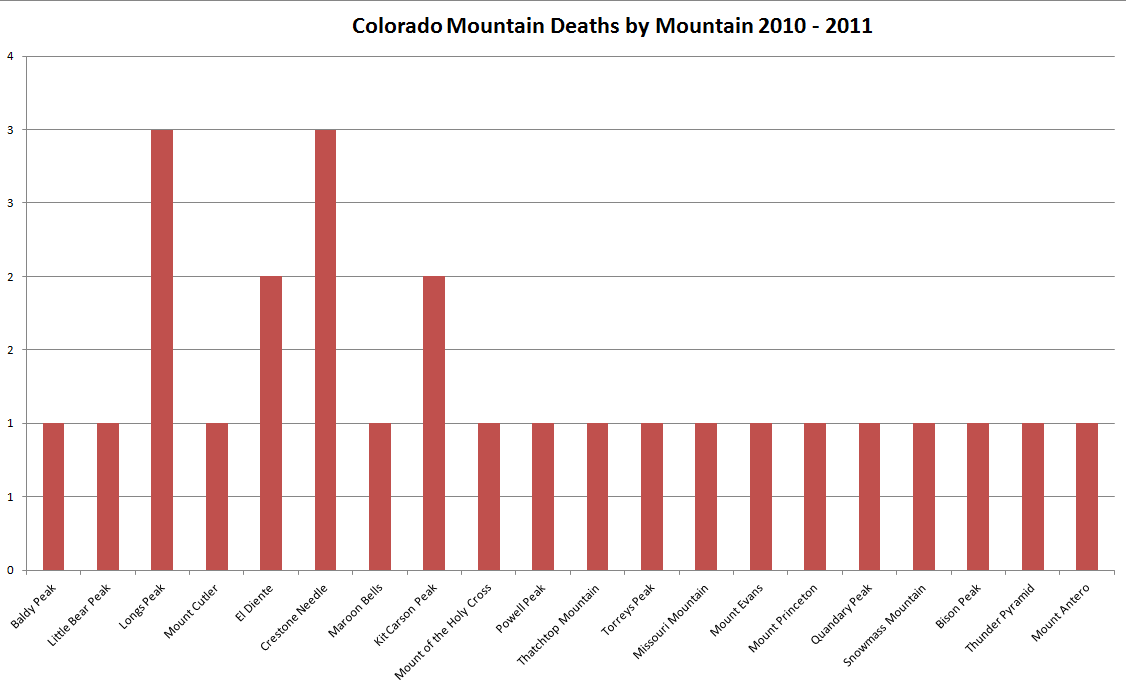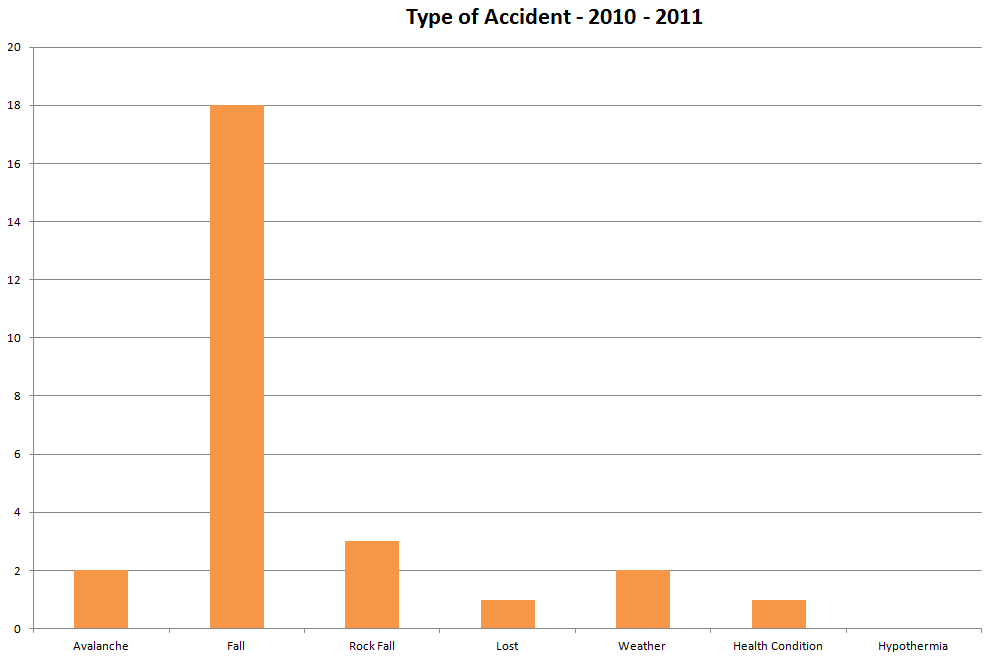
- Introduction
- Joel Levenberg – Torrey's Peak (Ski) - 5/21/2011
- Michael von Gortler and Makana von Gortler - Missouri Mountain - 6/22/2011
- Mary Elizabeth Bowles - Mount Evans - Sawtooth route - 6/25/2011
- Deanna Miller - Mount Princeton - 6/30/2011
- Mostafa Salehi - Quandary Peak - 7/17/2011
- Sean A. Wylam - Snowmass Mountain - 7/24/2011
- Frank Stanley - Bison Peak - 7/25/11
- Keith Rose - Crestone Needle - 8/1/2011
- Michael Lepold - Kit Carson Peak - 8/17/2011
- David Morano - Thunder Pyramid - 9/10/2011
- Wayne Kirkbride - Mount Antero - 9/25/2011
- Summary / Data / Charts / Common Themes
2011 started out very poorly in terms of Colorado mountaineering deaths. Through mid-July there had already been 6 deaths, which was on-pace for a record-setting year. Fortunately, the pace slowed and we ended the year with 12 deaths, 3 less than last year. While no entity keeps official records of mountaineering deaths in Colorado, the American Alpine Club publishes its annual Accidents in North American Mountaineering (ANAM) book, which highlights every known accident and death in North America as well as providing meaningful statistics, broken down by State and type of accident. The scope and purpose of that book is for mountaineers to read about accidents and to learn from them. Through analyzing what went wrong in each situation, ANAM gives experienced and beginning mountaineers the opportunity to learn from other climbers' mistakes. From inadequate protection, clothing, or equipment to inexperience, errors in judgment, and exceeding abilities, the mistakes recorded in the book are invaluable safety lessons for all climbers.
The purpose of these articles on 100summits.com is to focus more on Colorado Mountaineering specifically, and provide respectful analysis on each death if possible. It is also a goal that this website may serve as a historical reference for Colorado Mountaineering Accidents - at least 2010 and forward.
The philosophy is that each mistake, accident or unfortunate event has a valuable lesson attached to it. We also believe that even simple coincidences or freak accidents, where no fault can be laid upon the mountaineer, can be analyzed or studied. Perhaps in reading about one of these such accidents, other climbers may decide to avoid that mountain or take extra precautions when attempting to climb it. Additionally, most of us that climb mountains do so with the knowledge that it is dangerous and that accidents can and will occur. The only thing we can do to mitigate that risk is to educate ourselves, learn from others, and prepare as much as possible. The hope is that this continued work is a small means to that end.
1. Joel Levenberg – Torrey's Peak (Snowboard) - 5/21/2011
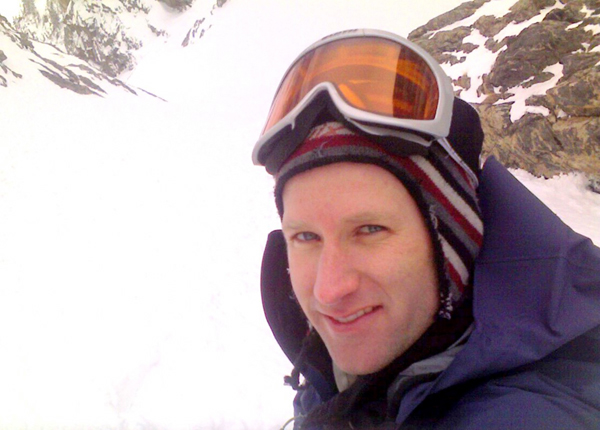
According to the Denver Post, Joel Levenberg was the first mountaineering victim of 2011. Even the 'easy' 14ers pose a significant avalanche risk given the right conditions, and 14,275 ft. Torrey's Peak is no exception. Joel Levenberg was a 38-year-old skier from Superior, Colorado. He died from the injuries he suffered in an avalanche while decending Torrey's Peak. He was found alive at about 12,800 feet in elevation, according to the Clear Creek County Sheriff's Department. The slide happened at about 1 p.m., and Levenberg complained of injuries to his chest and hip when rescuers reached him at about 5:30 p.m., according to a media release from the Sheriff's Department. Conditions were not ideal for mountaineering or snowboarding - the wind was blowing at more than 50 mph, which created white-out conditions. He could not be airlifted because of the conditions, authorities said. Levenberg died on the mountain from his injuries at about 7 p.m. His two companions said they had hiked to the summit of Torrey's Peak and decided to ski down. Levenberg went first, triggering the large slab to slide, they told authorities. According to the Colorado Avalanche Information Center, Levenberg was not buried, but fell approximately 1000 vertical feet through terrain with many exposed rocks, at least one of which he hit with substantial impact force.
A full report from the Colorado Avalanche Information Center can be found HERE.
Analysis
Levenberg's death seems to have been the result of classic spring avalanche conditions. While it is obviously clear that his death was avoidable, based on the conditions and the activity, this is often the case when discussing avalanche accidents. They are rarely the result of chance, rather, a result of putting oneself into a situation that is rather risky. While any casual observer would be correct in making very similar statements about mountaineering in general, it is particularly amplified in situations involving avalanches based on the greatly increased odds of an accident occurring in certain conditions. The best prevention is to learn how to interpret conditions, and to avoid areas that are prone to avalanches, which takes years of studying and experience to accomplish successfully, and even still, each year, there are examples of very experienced mountaineers and skiers that are caught in avalanches in Colorado because of how innately dangerous they are. Remember, if you are going to engage in skiing, hiking, snowshoeing, snowboarding or snowmobiling in areas prone to avalanches, be sure you are properly equipped, have a plan with your group, and a communication plan. A good place to start is to obtain education from a reputable source, including the Friends of Berthoud Pass or the Colorado Avalanche Information Center.
2. Michael von Gortler and Makana von Gortler - Missouri Mountain - 6/22/2011

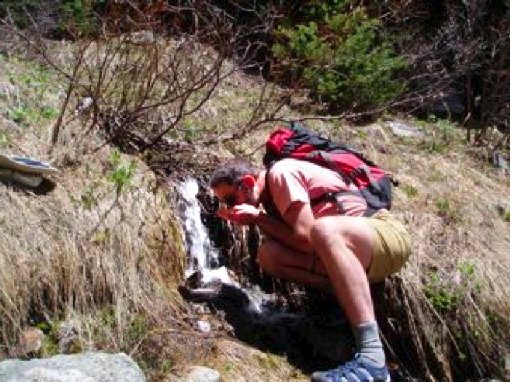
According to Dailycamera.com, Michael von Gortler, 53, and his daughter Makana, 20, a CU student, both likely died in an accidental fall on 14,000 ft. Missouri Mountain, although the details and specifics are still quite unknown and will likely remain that way for eternity. Both bodies had head and neck trauma consistent with a fall and were found off-trail.
After a five day search, helicopters spotted the bodies about 500 feet above the main trail at 12,000 feet. A backpack inscribed with the name "Von Gortler," along with other factors helped the coroner confirm that the bodies were those of Michael and Makana von Gortler.
Makana von Gortler was born in Boulder, graduated from Boulder High and was set to enter her junior year at CU as an ecology and evolutionary biology major and the president of the university's tango club.
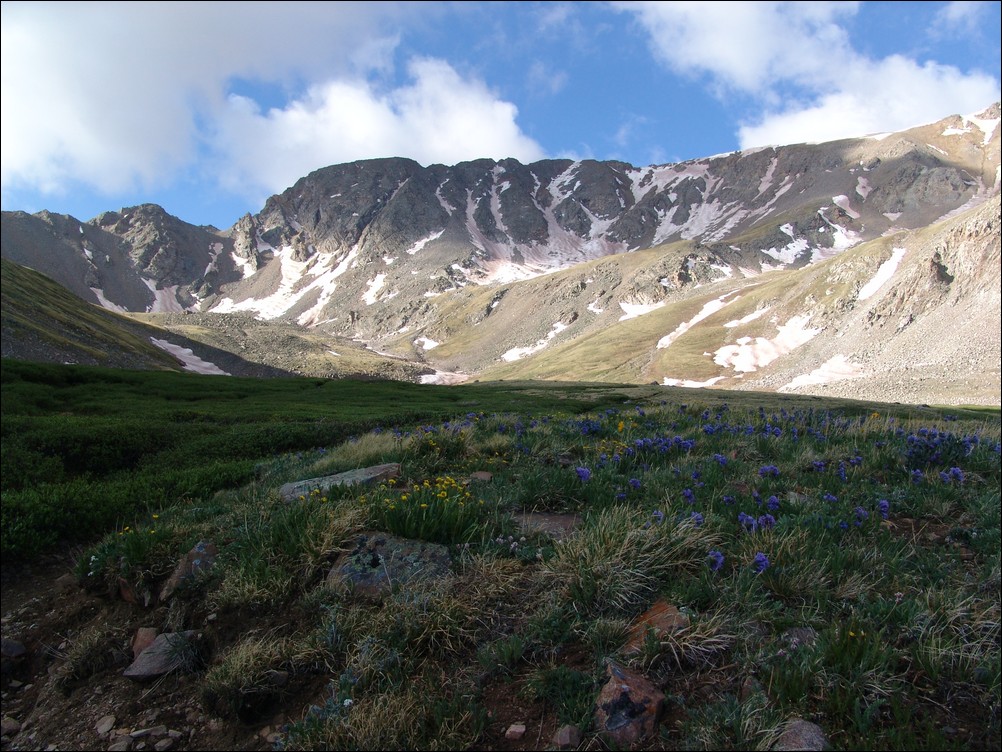
Missouri Mountain
Analysis
The analysis for the von Gortlers is a difficult one to make, given the extreme lack of details surrounding their death. One can only speculate as to what actually happened to cause them to fall to their deaths. Having climbed Missouri Mountain and circled the mountain's permiter, I can say with a high level of certainty that there is no reason that the pair should have been where their bodies were found, unless they went very off-route (some mountaineers, including myself, do this quite often). It would seem then, that the pair strayed off-route into an area that exceeded their expectations, or physical capabilities. It is uncertain if they were equipped with or trained to use the gear necessary for a successful off-route adventure on ice (reports state that there was significant ice near their bodies). The hard lesson that can be learned from this accident is that it is often not a good idea to go off-route unless you are absolutely confident of your route or abilities. Since both of those are based on one's subjective comfort level, mileage may vary.
As a caveat, I personally found myself in a very similar situation this past summer on Snowmass Mountain and should have been more careful (especially since I find myself writing about these situations each year). It is therefore very important to point out that this situation is probably quite common and each mountaineer should be cognizant of the reality that there are potential risks and hazards when venturing off-route.
3. Mary Elizabeth Bowles - Mount Evans - Sawtooth route - 6/25/2011
According to TheDenverChannel.com, Mary Elizabeth Bowles, a 50-year-old woman from Golden, Colorado, died in a fall from the Sawtooth Ridge, which connects the 14,000 ft. Mount Evans to another 14,000 ft. mountain, Mount Bierstadt. Bowles was not equipped with any mountaineering equipment (ice axe, crampons, rope, etc). According to rescuers, her party had recognized that they were ill-equipped to handle the terrain and were turning back when the accident occurred.
Analysis
During the summer months, the Sawtooth Ridge is a relatively straight-forward class 3 route on moderately steep terrain. Oftentimes, the route can appear to be dry from lower elevations when in fact the route is riddled with snow and ice, turning the route into a more technical route that may require an ice axe, crampons or rope. It would seem that this is what happened to Bowles' group at the time of her accident. The group was not prepared to encounter the terrain that they did, and as a result an accident occurred. It is very important that forethought be employed when engaging in serious mountaineering activities, especially during the late spring months where snowpack and ice may still exist. Bringing an ice axe and crampons (and knowing how to use them) is a good preventitive measure that one can take to help reduce the liklihood of finding oneself in a situation without the equipment that is required to complete a climb.
4. Deanna Miller - Mount Princeton - 6/30/2011
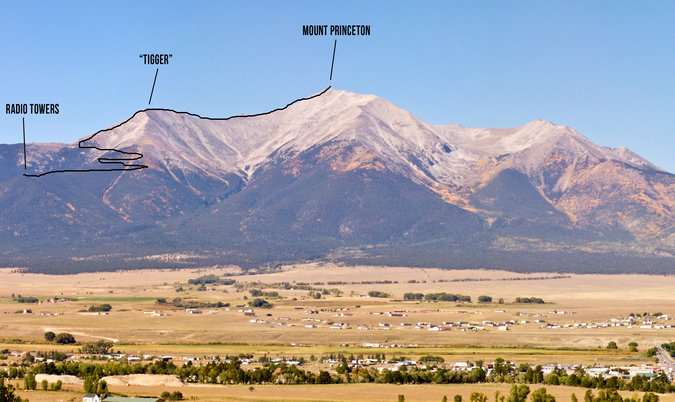
According to 9news.com, Deanna Miller was a 30-year-old woman from Denver, Colorado. According to kktv.com, and Chaffee County Sheriff Pete Palmer, Miller, a nurse, and a 28-year-old coworker made it to the top of Mount Princeton at 12:30 PM and on the way back down, a lightning storm started, and the pair left the trail to take cover under a boulder. At some point, the boulder toppled over and crushed Miller. Chaffee County Coroner Randy Amettis gave the cause of death as major crushing injuries to the chest.
Analysis
Deanna Miller's death is a tragic one that was most likely quite avoidable. It would seem that at least once a year someone falls victim to extreme weather on Colorado's 14ers. This tragic example evokes the age-old argument about when in the day to start climbing mountains. Some hardcore mountaineers live and die by the phrase, "up and down by noon," while others believe that it should all be a case-by-base judgement call made by the mountaineer. Personally, I find myself falling into the latter camp more often than not. Indeed, just this past year, I summited Wilson Peak at 5:15 PM. The key is to keep a sharp eye on the weather at all times and always know your exit strategy. Most importantly, don't feel bad for turning back if you see weather developing. I've turned back on several mountains over the years and there's certainly nothing wrong with that. Most summers and climbs, I do start quite early on my climbs (as early as 3 AM), and I have not had a lightning incident in quite some time. If you're curious about lightning in Colorado, I highly suggest you take a look at this great primer that was written by Casey Dorn.
5. Mostafa Salehi - Quandary Peak - 7/17/2011
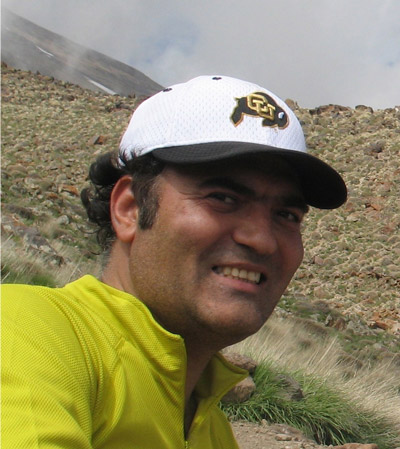
According to CBS4, Mostafa Salehi was a 48-year-old man that died from cardiac arrest near the summit of Quandary Peak. According to authorities, he had a history of medical issues and his death was consistent with a heart attack. Salehi was a contract employee at the National Institute of Standards and Technology in Boulder. He attended the University of Colorado in Boulder. To read more about Mr. Salehi, head over to dailycamera.com.
Analysis
It is hard to provide much in the way of a meaningful analysis regarding the death of Mr. Salehi. It would seem that it was known that he had health concerns and so perhaps the only thing to learn from his death would be to make sure you consult your physician if you have health concerns before you embark on a mountaineering adventure. With that being said, I would not be surprised if someday I develop a health condition and I am not sure I will let it stop me from enjoying the wonder that can be found deep within the Colorado mountains.
6. Sean A. Wylam - Snowmass Mountain - 7/24/2011
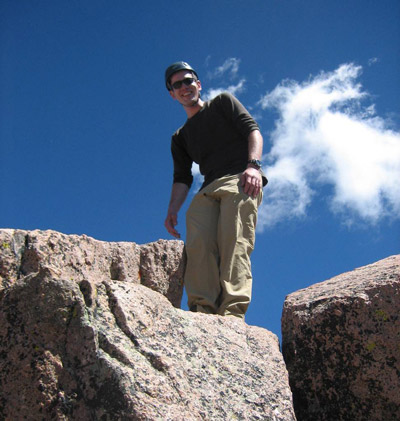
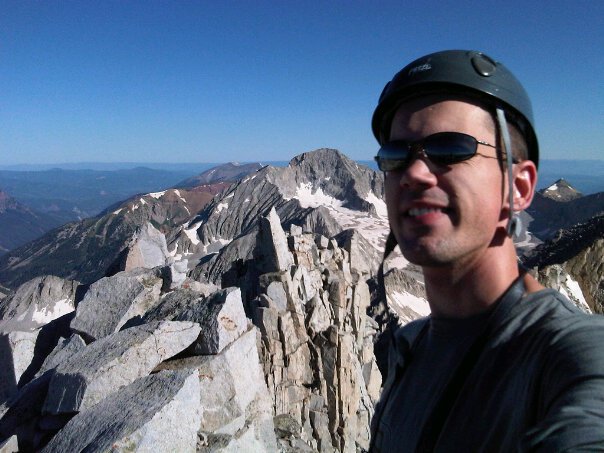
Top Photo by Alex Henes; Bottom photo by Sean Wylum, moments before his death on Snowmass Mountain...
Out of all of the deaths this past year, this one hit closest to home, for a number of reasons. For starters, one of my climbing parters from last year, Ryan Marsters, was the in the group to first get to Sean the day he died on Snowmass. The description that Ryan provided of the situation was harrowing. Second, I climbed Snowmass one week after this accident occurred, so it was in the back of my mind for a good deal of that climb. Additionally, Sean's death was incredibly memorable, being that he posted the above photo to his Facebook page moments before his death with the caption, "On Snowmass... now to get back down."
Sean's death is still somewhat a mystery, since there were no witnesses to his death, other than Ryan's group hearing the sounds of rocks. Sean died on the standard route down from Snowmass Mountain, apparently due to a fall on a loose rock. By all accounts, Sean was a class act and a great guy. He will certainly be missed.
Analysis
Sean's death is hard to analyze. The Elk Mountains are notoriously loose and dangerous and one single mis-step can be fatal, even on the standard routes of the easiest of peaks. Indeed, I discovered this the hard way just this past year on the same mountain during my own descent. I think Ryan Marsters summed it up best in his analysis of what happened: "Plain and simple, he stepped on the wrong block and a few tons of debris gave way beneath him in a thundering boom. Attribute it to freeze-thaw, mass wasting, saturation, and any combination of processes."
With all that said, when climbing in the Elk Mountains, it is incredibly important to test each step and hold before committing your entire body weight to it. Even the most stable looking rocks can be widowmakers in hiding.
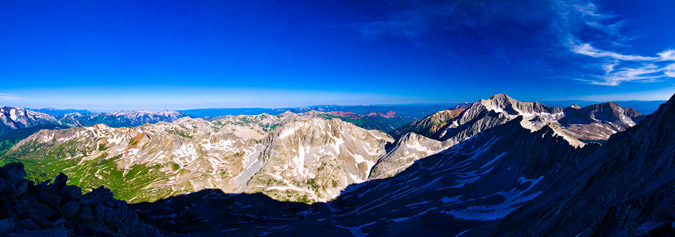
A view from Snowmass Mountain demonstrates the rugged nature of the Elk Mountains...
7. Frank Stanley - Bison Peak - 7/25/11
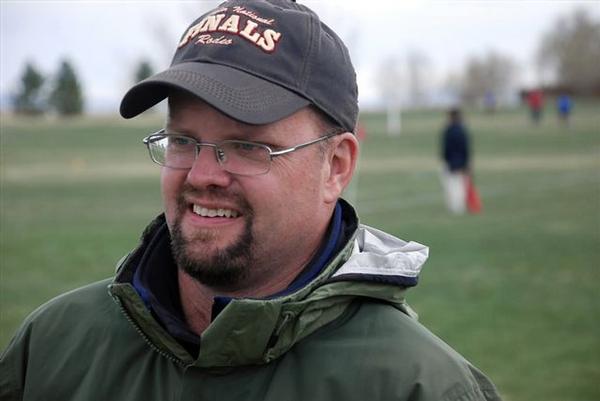
According to the Denver Post, Frank Stanley, 44, was gone for two weeks before someone reported he had disappeared after a hike up Bison Peak, a 12,431 ft. mountain located near the town of Taryall, Colorado. A popular day hike, Bison Peak does not have a reputation for being dangerous, by any means; however, given the right conditions, any mountain can be quite dangerous. Stanley taught math and physical education at the Ricks Center for Gifted Children at the University of Denver, as well as coaching the soccer team. He sent a text message to a friend on July 25th as he reached the summit, but was not heard from since. His family was unable to contact him and became worried, and later reported him missing on August 11th.
Analysis
Not much is really known about the details surrounding Mr. Stanley's death. His body was found far off any established routes for Bison Peak in a rugged area. His body took several days to recover due to its awkward location on the mountain. The best guess that anyone has about his death is that he found himself in quite a bad storm on the summit of Bison or nearby and had to bail quickly. Perhaps in a panic and confused by the weather conditions, Stanley may have retreated in the wrong direction and found himself in very rugged terrain and falled. It would seem that he suffered a similar fate as Deanna Miller, being in the wrong place at the wrong time during a bad storm.
Mr. Stanley also made one other critical error, although it would be hard to argue this since he was climbing a seemingly simple mountain in Bison Peak. He climbed alone and in bad weather. Additionally, based on the timing of the notification of him being missing by his family, it would seem that he did not let anyone close to him know about his plans to climb Bison, which most certainly increased the amount of time for his rescue (by two weeks). Again, it is very difficult to know what happened in his case; however, it does provide a good reason for letting your loved ones know about your whereabouts. I think that most people understand this concept, especially after seeing 127 Hours, the movie about another Colorado Mountaineer and Adventurer, Aron Ralston.
8. Keith Rose - Crestone Needle - 8/1/2011
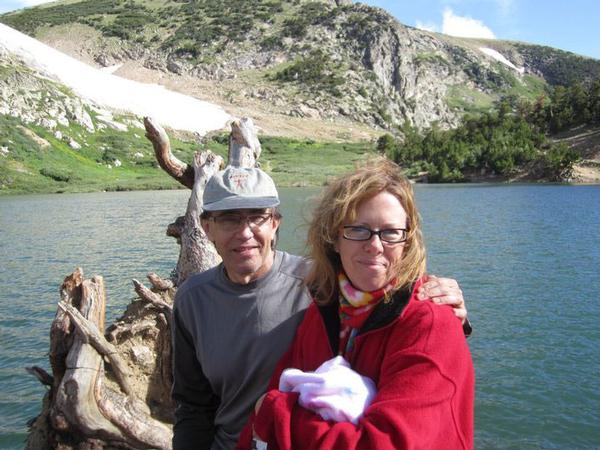
The death of Keith Rose is a true tragedy - he died in a fall while descending Crestone Needle. According to the Denver Post, Mr. Rose chose to celebrate his 50th birthday by climbing 50 of Colorado's 14ers in a 30-day span - quite the feat for anyone, let alone a 50-year-old. However, Rose was an experienced climber and had climbed many mountains in the past. According to rescuers, Rose fell 30 ft. in the Broken Hand Pass area while descending. There are numerous details about his death that are known, and I will go into more details about those in the analysis section.
Analysis
There are numerous things about Mr. Rose's death that can be learned from. One could safely state that Mr. Rose committed several mountaineering mistakes which I strongly believe contributed to his death. I want to be clear here - I wish no harm to his family or friends by reviewing this information, as I hope that it will benefit others in the future.
Before discussing those mistakes, let's review the details of the accident, as told by the Custer County Search and Rescue Team:
- At 11 PM, the SAR team was notifed by Mr. Rose's father that he had not met with him as planned in Gardner. The two had planned to meet there so Mr. Rose could get batteries and a new SPOT unit to replace one he had dropped and broken. According to his step-daughter, Cheryl Hedlun, Rose was using a new GPS device.
- Mr. Rose sent three text messages during his climbs of Crestone Peak and Crestone Needle:
- 4:00 AM: Boots on the ground
- 9:30 AM: Would you call dad. Lost 2-2.5 hrs on a loop, will be running late.
- 3:30 PM: Trying to make way back. GPS Batteries died. Will be even later. Think I can find the way.
Based on the above accounts, it would seem that Mr. Rose was using a new GPS and was not familiar with its battery life. It would also seem that he did not pack spare batteries, which, if you are relying on your GPS unit to navigate, would seem to be a fatal error. Additionally, he was climbing two of the most difficult 14ers solo, which also would be a critical mistake.
Finally, Mr. Rose made one more critical mistake. Let's review further, again from the Custer County Search and Rescue website:
- SAR members interviewed a couple who felt sure that they had seen and spoke to subject at approximately 3:00 PM while both parties were descending from Crestone Needle. Mr. Rose was reportedly off-route and both his GPS and cell phone batteries were depleted. Subject responded that he felt the couple were the ones off-route; and that he was on the same route he had earlier climbed. He would not retreat and join their party as requested.
Based on this information, it would seem that with a non-functioning GPS unit and a cell phone that was inoperable, Mr. Rose would have been wise to join up with the couple to safely descend. Even if they were the ones that were off-route, the group could make better decisions together and chances are higher for a successful rescue since there were two other people that could have flagged down help in the event of a fall.
Being an experienced mountaineer, Mr. Rose knew the dangers that the Crestones presented. As one can see from the below photo, the terrain of those peaks is quite rugged and dangerous. Even the most experienced climber could take a nasty fall and become injured.
My condolences go out to his family. It is my hope that reading about his death will prevent others from meeting the same fate on those dangerous peaks.
9. Michael Lepold - Kit Carson Peak - 8/17/2011
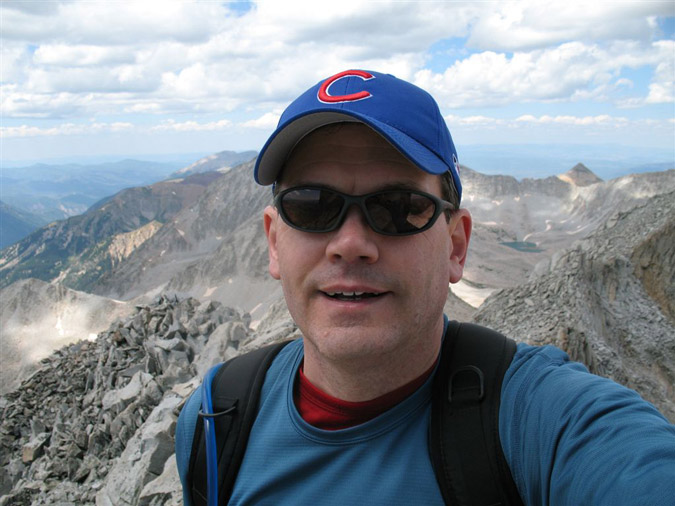
According to a post on 14ers.com by his cousin, and a website dedicated to him, Michael Lepold was a 52-year-old man from Glen Ellyn, Ill. According to his cousin: "It is with very sad news that my cousin, Mike Lepold was the fatality on Challenger (Kit Carson) Peak. On Wednesday he went on a solo hike. When he got to the top, he called his wife to tell her about his accomplishment. He was so proud about having completed another 14er. On his descent, he fell. Not being familiar with these mountains, you would probably have a good idea about where it happened. Based on some of the other posts, it appears to have been a very dangerous descent. Is there a place to put a memorial or a sign with his name as a fallen hiker? If so, please let me know. I would like to have his name posted. He loved hiking these mountains. I'm sure his obituary will be posted online in the Chicago newspapers. I'm sure the family would appreciate hearing from some of you that love these mountains as much as he did. His family and friends will miss him dearly."
There are not many details known about his death or why/how he fell or died. According to the Wet Mountain Tribune, "Custer County Search and Rescue (SAR) co-captain Cindy Howard and hiking companion Linda Brigham, who were hiking in the area, received notification from the Saguache County Sheriff’s office that an overdue climber had not returned as expected. His body was discovered by Howard and Brigham after exploring Challenger Point and making their way around to the east side of Kit Carson and the Outward Bound Couloir. Howard spotted the man’s remains on a ledge above a feature known as the bowl."
Analysis
Since no one really knows what happened to cause Mr. Lepold's death, it is incredibly difficult to speculate as to the cause. If any analysis could be made, it would be that he was climbing alone, which is generally highly correlated with a lower probability of survival in the event of an accident. There have been several deaths on Kit Carson Peak in the past couple of years, and many of them have been attributed to people going off-route on accident. Additionally, nearly all of those victims were alone. As you can see by my photo below, Kit Carson Peak is home to some incredibly rugged terrain; therefore, climbing on or around Kit Carson is best done with caution and in small groups. When in a small group that is prepared and educated on the climb, chances are higher that the proper route is chosen, in my opinion.
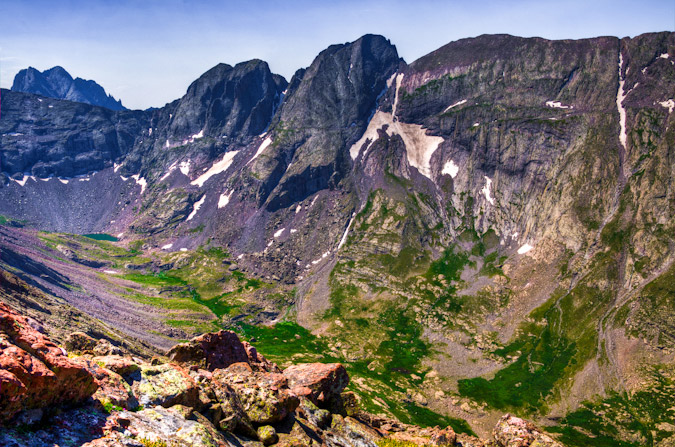
10. David Morano - Thunder Pyramid - 9/10/2011
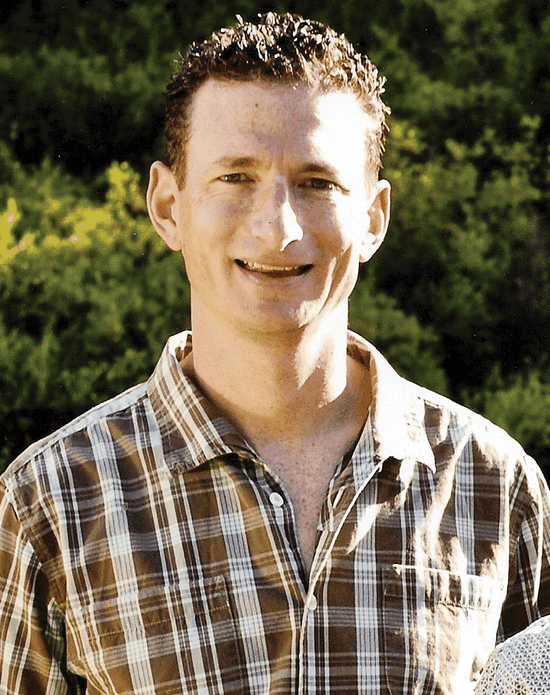
According to Summitdaily.com, David Morano, a 41-year-old from Dillon, Colorado, fell 200 feet to his death off Thunder Pyramid. Morano was climbing Thunder Pyramid with one other and was a very experienced mountaineer, having climbed 129 of the top 200 Colorado peaks. By all accounts, Morano's accident was a product of loose rock and a fall on dangerous terrain. For those not familiar with Thunder Pyramid, it is one of the most rugged and nasty mountains in Colorado, located deep within the Elk Mountains near the famous and also deadly Maroon Bells. At the time of this writing, I have personally not climbed Thunder Pyramid, but hope to within the next two years. Mr. Morano was an avid climber, hiker, skier and all around outdoorsman. He is survived by his wife Adele, his son Alex.
Analysis
Not much is known about Mr. Morano's death. It is reasonable to believe that his fate was very similar to that of Sean Wylum's - a victim of horribly loose rock in the Elk Mountains. Based on all accounts of David and the accident, I do not believe that there is much to gain from analyzing his death other than a repeat of caution about the type of terrain that is found on those mountains.
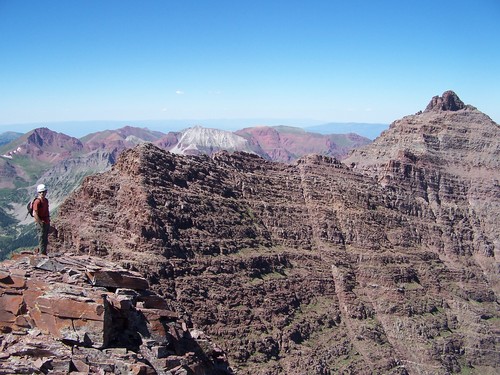
Thunder Pyramid - photo by Kiefer Thomas
11. Wayne Kirkbride - Mount Antero - 9/25/2011
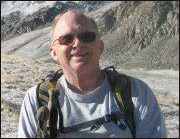
According to WALB.com, Wayne Kirkbride was a 61-year-old retired Special Forces officer and skilled mountaineer. According to the Denver Post, he was climbing a 14er, Mount Antero, when he was last seen. Kirkbride was staying at Mt. Princeton Hot Springs Resort with his wife. At 1:15 PM on Sept. 25 Kirkbride left to hike up Mt. Antero. His wife called the sheriff's office when he didn't return later that day. On Monday morning, Chaffee County Search and Rescue ground crews went looking for him. A Chaffee County Sheriff's Office deputy found his car at the Cascade Hill trailhead, which is not a standard route for climbing Mount Antero. According to his wife, Kirkbride was an exceptionally skilled otudoors man and has previously climbed eighteen 14ers.
Analysis
Since almost nothing is known about what happened to Mr. Kirkbride, it is difficult to analyze the accident that caused his death; however, there are three factors that I want to focus on:
- Mr. Kirkbride did not leave until 1:15 PM to climb Mount Antero. This seems highly suspect to me - he was experienced and probably knew that starting at that late of a time would be foolish considering he chose a much more difficult route.
- Mr. Kirkbride was climbing alone - while this is not uncommon on easier 14ers like Mount Antero, it would be ill-advised for someone to do this on an alternate route that is much more difficult.
- It is noted that he climbed eighteen other 14ers - I do not believe that this makes him an experienced mountaineer, by any means. Whether or not this contributed to his death is unknown. It is reasonable to believe though, that since he was retired Special Forces, that he did have some working knowledge of survivalism and mountaineering; therefore, I rate this concern as a wash.
I don't believe that Mr. Kirkbride was truly attempting to climb Mount Antero the day he died. First of all, the route he was found on is not a known route for Antero by most people. Second of all, a departure time of 1:15 PM would not afford him enough time to summit before dark, and I believe he would have known this. With these concepts in mind, I believe that his death is even more of a mystery in terms of what he was out there doing.
Summary / Data / Charts / Common Themes
While 2011 was not nearly as deadly as 2010, it still marked the passing of 11 truly great people that will surely be missed by friends and loved ones. Surprisingly, there were no deaths on Longs Peak this year, nor were there any deaths in the entirety of the San Juan Mountains, which is quite remarkable to say the least.
My hope is that the data I track through this painstaking annual endevour will become useful someday for research or for education purposes. Perhaps someday an organization will use this data to fund a new education program at the Park Service or some other organization. Who knows.
The first table I'd like to present this year is the Colorado Mountaineering Deaths by Mountain 2010 - 2011. If the table is hard to read, feel free to click on it to see a larger version.
As you can see, Longs Peak, El Diente, Kit Carson Peak and Crestone Needle are the most dangerous mountains in terms of the number of accidents.
The second table I'd like to share is a count of the type of accidents:
Clearly, the leading cause of death in Colorado Mountaineering accidents from 2010 - 2011 were falls.
Lastly, I'd like to share the table that shows a count of the contributing factors for the Colorado Mountaineering Deaths - 2010 - 2011:
I think that this data will become more and more interesting as the years progress, and will give educators, policy makers, and other groups some ammunition to begin targeting various interventions that would hopefully reduce the number of accidents per capita for Mountaineering Accidents.
If you have any comments or concerns about the data or ideas on other data points to start tracking, please leave a comment below. Additionally, if there are discrepancies in the information I provided above, please leave a comment so I can fix it.
{fcomment}


